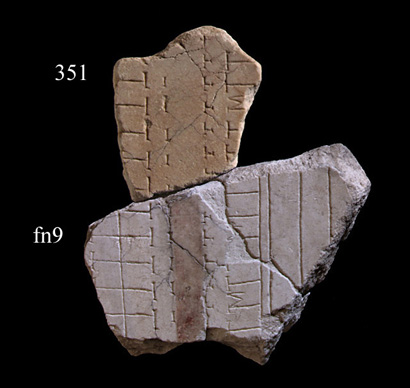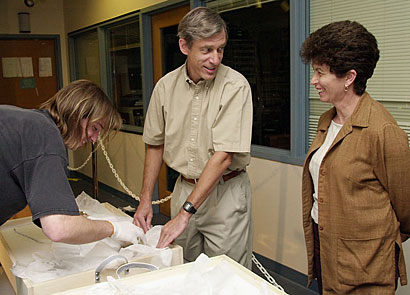Technology speeds up efforts to piece together ancient marble map of Rome
Algorithms, computers help researchers find at least seven new 'high probability' matches, dozens more worth investigating
BY GEOFF KOCH
Nearly every leading Italian archaeologist interested in ancient Rome sat in the chandeliered room of the German Archaeological Institute on March 18 to hear Marc Levoy, associate professor of computer science and electrical engineering at Stanford, describe efforts to build an online archive of what remains of the Severan Marble Plan, or Forma Urbis Romae -- a massive marble map of third-century Rome.

Doctoral student David Koller identified fragments as depicting
a section of the Circus Maximus. Courtesy of Digital Forma Urbis
Romae Project
But it was Levoy's soft-spoken doctoral student David Koller who stole the show. Koller did much of the work to scan pieces of the map and write computer programs to search for matches among the fragments. A typical academic paper about the map might propose a new match between two or three fragments, a new placement for a fragment within the city or a new interpretation of the incised lines on a fragment. When Koller put up a slide listing his proposed new matches -- at least seven of high probability and dozens more worth investigating -- there was an audible gasp from the audience, according to Levoy.
In his efforts to piece together the map's fragments, Koller has averaged nearly one match per month since 2003. This is a dramatic acceleration of a task that has tantalized scholars for centuries.
"We're on the brink of a huge expansion of knowledge," said Jennifer Trimble, assistant professor of classics and co-director with Levoy of Stanford's Digital Forma Urbis Romae Project. "We can study the urban fabric of the city, the neighborhoods and the use of public and private space."

Former doctoral student James Davis, left, unwraps a fragment of the ancient marble map of Rome with Marc Levoy and Laura Ferrea, an Italian archaeologist. Photo: L.A. Cicero
The project is a unique collaboration between Stanford computer scientists, their colleagues in the Classics Department and Italian archaeologists.
"The Stanford team's results are very impressive, and the methods are inherently convincing," said Andrew Wallace-Hadrill, director of the British School in Rome. "And I, at least, came away persuaded that this is a really important new tool which will enable us to make a big leap forward in piecing together what you can think of as one of the biggest jigsaws in the world."
Colosseum, Circus Maximus and more mapped
The Forma Urbis is unprecedented in size and detail. The mapmakers, likely commissioned by the Roman imperial government, chiseled the features of the city into huge marble slabs sometime between A.D. 203 and 211. The completed map measured 60 feet by 43 feet and hung in the Templum Pacis, one of the grandest public monuments in ancient Rome. The map depicted nearly every architectural feature of the city, from large public monuments, like the Colosseum and the Circus Maximus, to small shops, rooms and even individual staircases.
Today, no more than 15 percent of the map survives. As the Roman Empire dissolved, the lower part of the map was gradually ripped from the wall, probably to be burned in kilns to make lime for cement. The remainder fell off sometime during the Middle Ages, broke into pieces and was gradually buried by other debris.
Tragically, even after recovery of the map began during the Renaissance, some pieces were further broken up and used to construct a wall in the "Secret Garden" of the Farnese Palace in Rome. Scholars think that all of these pieces have been recovered. And though the map will never be fully reassembled, it lives on in the consciousness of modern-day Rome. Today, vendors sell postcards and city maps that display superimposed fragments of the Forma Urbis Romae.
Software both archives and protects intellectual property
The significance of the Digital Forma Urbis Romae Project is twofold. First, understanding of the artifact has been hindered by a dearth of publications. The most famous work about the map, a 1960 book by a group of Italian scholars, is hard to find outside of specialized research libraries because just 400 copies were printed. (The last surviving author of this book, Lucos Cozza, was on hand for the March 18 presentation.)
Second, the archive, which consists of 3-D models and high-resolution color photographs of the surviving map pieces, plus text descriptions and bibliographic information, offers a different experience than just leafing through static photos or reading journal articles. The 435 models that are currently available are made up of three billion polygons. This is nearly one hundred times the size of the next largest computer model of a cultural artifact -- the 3-D version of the David, which Levoy created as part of the Digital Michelangelo Project a few years ago.
Stanford computer science doctoral students Natasha Gelfand and Austen McDonald contributed to building the archive by processing the raw data that Levoy and other Stanford students collected in weeks of all-night scanning sessions in Rome.
Levoy is especially proud of the team's work to develop ScanView, custom software written by Koller and undergraduate Michael Turitzin to allow anyone with a personal computer and Internet connection to virtually manipulate map fragments.
"This [secure] viewer lets the public spin around our 3-D models of the map fragments on their PCs but doesn't let them download the model geometry itself," Levoy said. "The need for security for these models might seem surprising, but it was a request made by the Archaeological Superintendency [of the City of Rome]."
Such reticence is not unique to the Italians. Indeed, most museums exercise some level of control over the intellectual property rights associated with their collections.
The computer scientists could not have succeeded without the contributions of their humanities colleagues, such as Tina Najbjerg, a Stanford archaeological research fellow. For every fragment, Najbjerg identified the point where each incised line reaches the fragment's broken edge, noting which direction the line is headed and what its architectural function might be. This was no mean feat -- Najbjerg had to come up with 158 labels for the different types of incisions on the map. They ranged from "sl" for "straight line" to "tewpwa" for "end wall of row of tabernae that faces a passageway which is probably an alley."
It was painstaking work that only someone with Najbjerg's training -- she received a doctorate in classical archaeology from Princeton in 1997 -- could perform. Najbjerg also contributed to the exhaustive literature review and descriptive text that appears in the archive.
Before computer assistance, archeologists found matches at the rate of one every few years. For decades, limited access to the fragments and their unwieldy nature -- they weigh up to several hundred pounds each -- have slowed down those working on the puzzle.
"Scholars used to write whole articles and gain massive academic points for adding one new [match]," said Elizabeth Fentress, an Oxford-educated archeologist.
At first, it was not clear that the use of computers and algorithms would help matters much. Koller's first pass through the raw data returned more than 250,000 possible matches. However, steady improvements in the pattern-matching software and use of different algorithms in combination considerably reduced false positives.
In addition to university funding, the project is supported by the National Science Foundation, the United Parcel Service Foundation's Educational Endowment Fund, Interval Research Corporation, the Paul G. Allen Foundation for the Arts, the Mellon Foundation, the City of Rome and Logitech co-founder Pierluigi Zappacosta.
Back to the past, back to the future
Much of the project will conclude this summer, by which time the team will have completed its public archive of all surviving map fragments. Trimble said that one of the core project goals -- exploring urban planning in ancient Rome -- will be the focus of her next book. The map shows in compelling detail how the city was marked by a mix of spaces devoted to monuments, shops, religious buildings and private residences for a range of socioeconomic classes.
This mixing is all the more noteworthy given the size of the city. At the height of Rome's influence, its empire stretched from London to North Africa to Jerusalem, and the city was home to more than a million people. The relationship of these public and private spaces might be relevant to those working to solve urban sprawl today, Trimble said.
Levoy is excited by the prospect of trying out a new set of algorithms, developed for the field of genetics, to look for matches between fragments. Algorithms used in the Human Genome Project are robust enough to bridge the large gaps between markers on RNA sequences. His team faces the challenge of dealing with gaps of a different kind -- those that correspond to missing pieces of the fragments.
Levoy's growing reputation as an expert in scanning cultural artifacts is leading to other opportunities atypical for a computer science professor. He has been contacted about the possibility of scanning surviving fragments of the Lighthouse of Alexandria, one of the seven wonders of the ancient world. The fragments now lie in shallow water in the Mediterranean. Archiving them would involve complex underwater scanning.
Koller will work through the summer looking for additional matches. His success so far has come at a price. At the outset of the project, a skeptical Koller bet Trimble a case of wine that they wouldn't find any matches. But Koller is not complaining about having to pay up. He recalls sitting in a high school Latin class in Indiana and sketching pictures of the Circus Maximus, to which ancient Romans flocked to see chariot races. The work he presented in Rome solved a portion of the map depicting the Circus Maximus.
Almost certainly, his quiet work on the third floor of the Gates Computer Science Building will be punctuated by new discoveries. "However briefly, I know something about ancient Rome that no one else in the world knows," he said. "These are eureka moments."
Geoff Koch is a science writing intern at the Stanford News Service.


